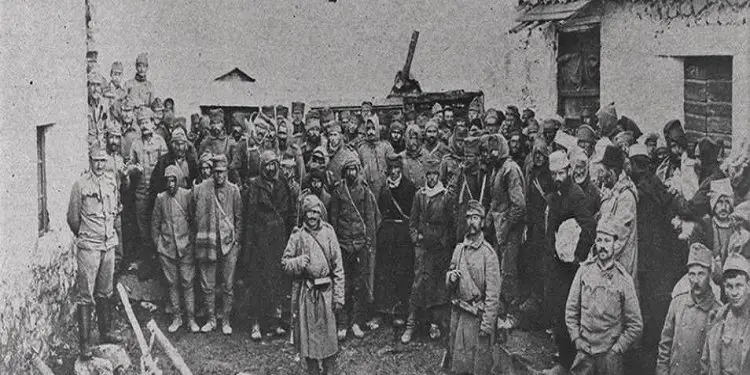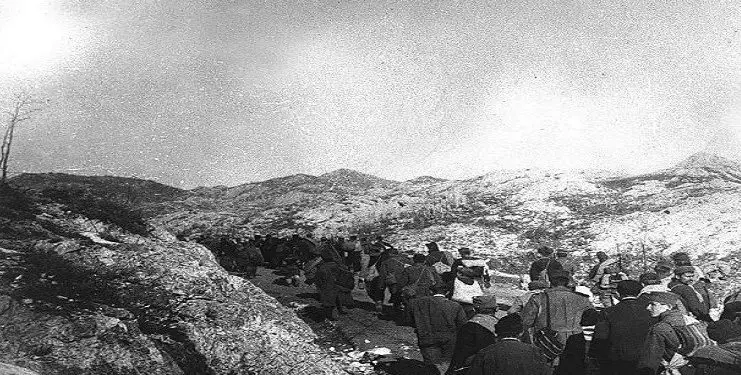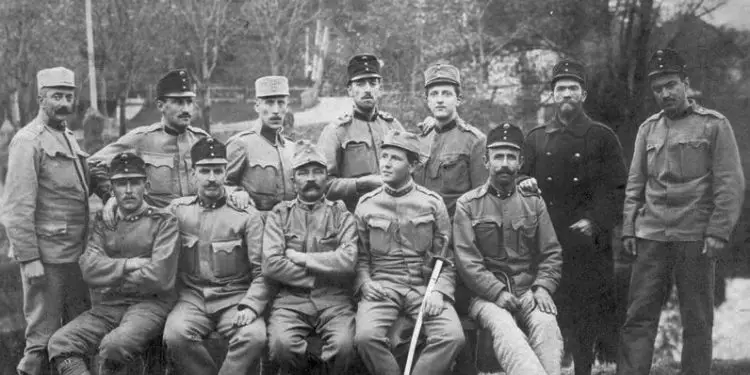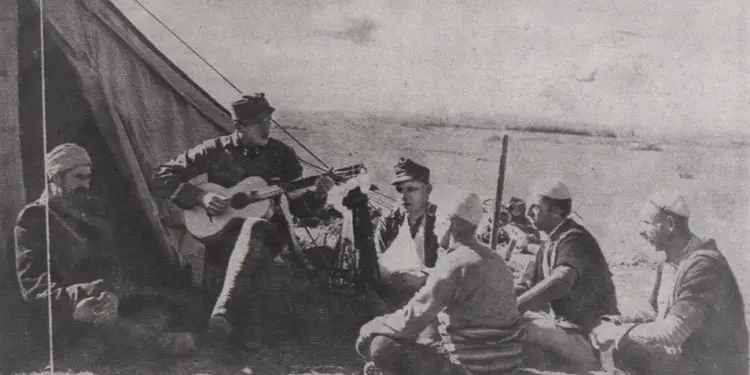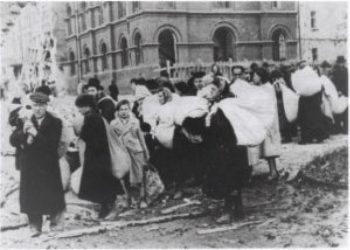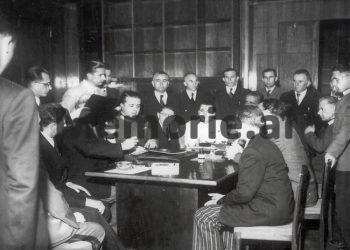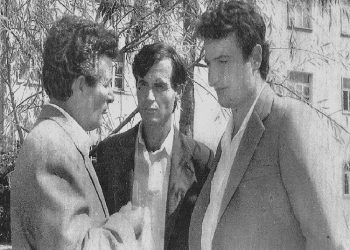From Bashkim Trenova
The ninth part
ALBANIANS ACCORDING TO THE SERBS
(THE EASTERN CRISIS AND THE BALKAN WARS)
Memorie.al / “Serbs are descended from the Slavs, a large number of tribes who gave life to the Slavic peoples. Knowledge about the origins of the history of the Slavs is modest and not so clear. Their name appears for the first time in the 6th century AD, when Byzantine writers start talking about the Slavs….”! (Dushan Bataković, Milan St. Protic, Nikola Samardžić, Aleksandër Fotic. History of the Serbian People. L’Age d’Homme. Lausanne. 2005. Pg. 3.)
Continues from last issue
INSTEAD OF THE PROLOGUE – A PROJECT, TWO MEMORANDA AND AN ANALYSIS
The Project or Nacertania of Ilia Garasanin – politician, prime minister of Serbia during the years 1852-1853 and 1861-1886:
MYTH-MYSTICISM, VICTIMOMANIA, RACISM AND SERBONOSTALGIA
The first head of the Albanian government in Vlora, Ismail Kemal Bey (Albanian: Ismail Qemali), was a protégé of Austria-Hungary and, therefore, a fierce enemy of Serbia, which was in conflict with the Albanians after its military successes in The First Balkan War. The Serbs, in order to reduce their encirclement by Austria-Hungary, were looking for an exit to the Adriatic Sea, in the Albanian territory. Under the strong pressure of Vienna at the Conference of Ambassadors in London, Serbian troops were forced to withdraw from Albania. (1)
—
The Serbian government was following the development of the situation in Albania with great concern. From the end of spring 1914, the Serbian Prime Minister Nikola P. Pashič repeatedly sent money to the heads of the Albanian clans through the mayor of the Ohrid district, prefect Jovan Čirković. This had few tangible results, as the amounts of gold and ammunition supplied to the Albanian leaders were small compared to the considerable sums distributed by Austro-Hungarian agents. Jovan Ćirkovic, the confidant of the Serbian prime minister, worked hard to ensure that cooperation with the Albanians in northern Albania, bordering Serbia, continued, “Because these hungry barefoot Albanians will go to those who give them bread and Austria waits with open arms”. His predictions came true… (2)
—
1 – Dushan T. Batakovic. Ahmet Bey Zogu et la Serbia. Une cooperation inachevée (1914-1916). (Ahmet bey Zogu and Serbia. An unfinished cooperation). Balkanica XLIII (43), January 2012. Page 170.
2 – Ibid. Pg. 172.
Since the Balkan Wars (1912–1913), the regions bordering Albania in areas with a large Albanian population were often the target of armed attacks by Albanian outlaws (kacakas), financed and organized by Austro-Hungarian agents and the Young Turk emissaries, with the aim of expanding Albania’s borders and creating Greater Albania, with the territories recently included in Serbia: Kosovo, Metohija and northwestern Macedonia (the regions of Skopje, [Uskub], Tetovo, Gostivar, Dibra [Debar], Manastir and Ohrid.)…
Austro-Hungarian agents supplied the Albanian leaders who emigrated from Kosovo – Isa Boletini, Bajram Curri, Hasan Bej Prishtina and others – with weapons and money. (1)
A secret agreement, signed with Esad Pasha in Nis, on September 17, 1914, regulated this aid and relations between Serbia and Albania in 15 points. The agreement provided for: (1) the establishment of lasting peace and friendship between the two countries; (2) non-conclusion of an agreement with another state, which would threaten the interests of one of the signatories; (3) Serbia would help restore order in Albania according to local traditions and the needs of the Albanian people; (4) Serbia would help create a legislative council of the Albanian people, composed of representatives of all clans; (5) the ruler of Albania would be appointed by the Great Assembly of the Albanian People, consisting of two representatives for each clan; (6) all parties would recognize the sovereign designated by the Assembly; (7)
Esad Pasha undertook to create, in cooperation with Serbia, joint representations in foreign countries and to organize joint defense and joint transport; (8) a joint body would be created to oversee this partnership and joint institutions; (9) Esad Pasha would put an end to the anti-Serb agitation in his territory, give the Christians freedom of worship and allow them to be educated in their own language; (10) a joint Serbian-Albanian commission, to be formed later, would decide on the demarcation of borders between Serbia and Albania;
1 – Dushan T. Batakovic. Ahmet Bey Zogu et la Serbia. Une cooperation inachevée (1914-1916). Balkanica XLIII (43), January 2012. Pg. 174.
(11) Esad Pasha would not object to the construction of an Adriatic railway to Durrës, and the Kingdom of Serbia would compensate the owners of the confiscated land for its construction; (12) to carry out this agreement, Serbia would pay Esad Pasha 50,000 dinars per month until the sovereign of Albania was elected, then another agreement would be concluded, which determined a new amount of compensation; (13) the armies of both parties could cross the border only at the invitation of the other party; (14) the agreement would be ratified by the sovereigns of Serbia and Albania as soon as the latter was appointed; (15) Esad Pasha undertook not to undertake anything that would go against this agreement and to work closely with the representative of the Kingdom of Serbia in Albania, whoever was appointed to this position. As Nikola Pašić explained later, this agreement was concluded “just to protect us from the attacks coming from this side, until the war ends”. However, it is undeniable that it constituted a framework for future relations with Albania.
Prime Minister Pashič ordered in May 1915 an intervention of military forces in Albania, despite the disapproval of the allied governments. They entered northern Albania from three directions. The Serbian troops, under the command of Colonel Dragutin Milutinović, quickly broke the resistance of the “Ottomans”, occupied Tirana and Elbasan, and freed Esad Pasha, who was already surrounded in his fortress in Durrës. The leaders of the “Ottomans”, including Haxhi Qamil Feiza, Musa Efendi and the mufti of Tirana, were captured by the Serbs and handed over to Esad Pasha, who hanged them in Durrës. (1)
1 – Dushan T. Batakovic. Ahmet Bey Zogu et la Serbia. Une cooperation inachevée (1914-1916). Balkanica XLIII (43), January 2012. Pg. 177. See also; D.T. Bataković, “Sećanja generala Dragutina Milutinovića na komandovanje albansim trupama 1915”, Miscellanea (Mešovita Gradja) XIV (Belgrade: Institut d’Histoire, 1985), 117–119, 128.
Thanks to Lieutenant Mladen Stamatovic, Pašić’s emissary in Albania, Ahmed Bey was appointed head of the Serbian administration of the Mat district by Colonel Milutin Miškovic, commander of the Drin unit (Podrimski odred) in Dibër, and by General Damnjan Popović, commander of the troops of New Regions (Commander Trupa Novih Oblasti), including Old Serbia [former vilayet of Kosovo] and Slavic Macedonia [vilayet of Manastir]. The Serbian military authorities did not seem to have much faith in Esad Pasha and even entrusted Zogu with a cannon, which they had placed in Lis-Burgajet, “all this so that our military authorities could protect Ahmed Beu from Esad [Pasha]”.
After a Serbian administration was established in the occupied northern areas as well as in Central Albania, the commander of the Serbian troops in Albania, Colonel Dragutin Milutinovic, tried to end the existing disagreements between Esad Pasha and Ahmed Zogu in order to prevent new confrontations between cousins turned rivals. (1)
—
Meanwhile, on November 13, 1915, many lords from South, North and Central Albania had gathered in the village near Ahmed Bey’s apartment. Among them was Bajram Curri, a tribal leader from Kosovo from where he had fled, and the influential Catholic priest, Jozefi from Oroshi. They sought to take advantage of the predicament in which Serbian troops found themselves on various fronts facing the Bulgarian, German and Austro-Hungarian armies to call for a concerted uprising against Serbia. The most ardent supporter of the uprising was that Joseph, who had received money from the Austro-Hungarian minister in Athens, as well as precise instructions to raise the mirditors against Serbia. During the rally, Jozef i Oroshi tried to incite the other Albanian leaders: “Serbia must be destroyed and we Albanians, if we stand up, can reach Skopje and Albania will be much bigger than now”.
Joseph of Oroshi was supported by the famous Hassan Bey, who had wanted to prevent the Serbian army from retreating through Albania and who proposed entrusting the command of the uprising to Ahmed Bey Zog. Thanks to the intervention of Stamatovic, Zog’s forces would not fight against the Serbian army, exhausted by hunger and the cold of the severe winter in the snowy Albanian mountains, while some members of the tribes of Mati, especially in the border territories with Mirdita, attacked, robbed and killed starving soldiers as well as numerous Serbian civilian refugees in their painful retreat to the Adriatic coast. (2)
1)Dushan T. Batakovic. Ahmet Bey Zogu et la Serbia. Une cooperation inachevée (1914-1916). Balkanica XLIII (43), January 2012. Page 177. See also; D.T. Bataković, «Sećanja generala Dragutina Milutinovića na komandovanje albansim trupama 1915» [Mémoires du général Dragutin Milutinović, commandant les troupes albanaises en 1915], Miscellanea (Mešovita Gradja) XIV (Belgrade: Institut d’Histoire, 1985), 117–119, 128 .
Serbia, with its democratic regime and its clearly expressed national aspirations, becomes relatively quickly…a real Piedmont of the Balkans. (3)
Kosovo-Metohija is – as agreed not only by political actors, parties in power or opposition, but also national institutions and public opinion – an important space in the Serbian state in many ways: historically, as it is the traditional hearth of Serbian culture; economically, because with its mineral resources it is the richest part of Serbia, essential for its economy; geopolitically, because it gives it a weight that corresponds to its potential in an unfavorable political environment.
1) – Dushan T. Batakovic. Ahmet Bey Zogu et la Serbia. Une cooperation inachevée (1914-1916). Balkanica XLIII (43), January 2012. Pg. 177. See also; D.T. Batakovic, “Sećanja generala Dragutina Milutinovića na komandovanje albansim trupama 1915” [Mémoires du général Dragutin Milutinović, commandant les troupes albanaises en 1915], Miscellanea (Mešovita Gradja) XIV (Belgrade: Institut d’Histoire, 1985). Pg. 181-182.
2 – Ibid. Pg. 184-185.
3 – Dushan T. Batakovic. Nikola Pashič, les radicals et la “Main noire”. Les défis à la démocratie parlementaire serbe. BALCANICA XXXVII, Belgrade 2007. Pg. 143.
For the vast majority of Serbs, Kosovo-Metohia is important as the center of Serbian culture: it is the area that has the largest number of Serbian monuments dating from the middle Ages, nearly 1,800 churches, monasteries, hermitages, cities, fortresses, including monasteries with invaluable importance for Serbian culture, history and tradition. Kosovo-Metohia is the “Jerusalem of Serbia”; the similarity to the Israeli case, both in past and contemporary history, despite some differences, is not unfounded.
Former Ottoman provinces – Greece in 1830, Serbia and Montenegro in 1878 (along with Romania), Bulgaria in 1908 – became independent states, while other provinces, populated mainly by their countrymen, remained under Ottoman rule or Austro-Hungarian. The new states, seen as the nucleus of a future national union, according to the nation-state model, were conceived as a step on the long road to national liberation. The Balkan Wars of 1912 and 1913 ended the disintegration of Ottoman power, with Albania as a new state, proclaimed in November 1912, establishing permanent, temporary or disputed borders between the Balkan countries.
The result of the First Balkan War (October 1912 – April 1913), despite the doubts of the Great Powers, was surprising. The Balkan allies (Serbia, Bulgaria, Greece, Montenegro), after secret treaties signed on a bilateral level, prevail on all fronts against the Ottoman forces: the Serbs occupy Kosovo, a part of the Sanjak of Novi Pazar and Upper Macedonia, a vast territory with the cities of Skopje, Prilep, Manastir and Ohrid, exceeding the borders approved by the treaty of March 1912 with the Bulgarians; furthermore, the Serbian army, seeking access to the Adriatic Sea, invaded Northern Albania.
The delimitation of the disputed areas was discussed, under the auspices of the Great Powers, at the Conference of Ambassadors gathered in London (1912-1913). Austria-Hungary, the protector of the Albanians, supported by Germany, in order to exclude Serbia from the shores of the Adriatic, imposed the solution according to which autonomous Albania and Montenegro would have “anyway a common border”, making the exit impossible. of Serbia (supported by Russia) in the Adriatic.
1 – Dushan T. Batakovic. Kosovo-Metochie: Regionalism, regroupement ethnique ou paratage? Kosovo.com: Project Rastko Gracanica-Pec. Also published in Italian under the title: “Progetti serbi di spartazione”, Kosovo: IL triangolo dei Balcani, Limes, No 3, Rome 1998, pp. 153-169.
On November 9, 1921, the League of Nations recognized the de jure government of Albania, justifying some Albanian claims in the border regions with Greece and Yugoslavia. However, the ill-defined Albanian borders, with a weak but ambitious regime towards the territories of neighboring countries, remained contested by Yugoslavia and Greece during the 1920s, creating a crisis ready to explode in the region. (1)
—
The history of Serbia has been widely appreciated for its important role in various regional and sometimes world events. (2)
—
For the Serbs, Kosovo represents, first of all, a Serbian “Holy Land”, whose cultural and economic development rises from the end of the Middle Ages, and is brutally interrupted by the Ottoman victories as well as the isolation from its European and Christian background. (3)
1 – Dushan T. Batakovic. Les frontières balkaniques au XXe siècle. (Balkan borders in the 20th century). Cairn.info. 01.12. 2008.
2 – Dushan T. Batakovic. Let drama du Kosovo en Serbia. A historical perspective. (The drama of Kosovo in Serbia. A historical perspective). Belgrade: Čigoja štampa, 2012. Pp. 9.
3 – Ibid. Page 15.
Although the majority of its population today is Albanian, Kosovo has been valued as a national and cultural embodiment of the identity of the entire Serbian people. For the ordinary Serb of our days, the word Kosovo always represents an ancient and holy Serbian land, where Serbs have been systematically persecuted and expelled more than during the last three centuries, excluding the last Yugoslav period, simply because they are Slavs and Christians orthodox.
In this context, not only the invaders, the Ottoman Turks, but also their local allies, first the Muslim Albanians who came down from the mountains of Northern and Central Albania and settled in the fields of Kosovo and Metohija in different periods of time, are seen as persecutors during the Ottoman rule (1455-1912), during the occupation of Italian fascists and German Nazis (1941-1945) and during the communist regime of Tito (1945-1990).
The Muslim Albanians of the mountains of Northern and Central Albania, the poorest regions of European Turkey, were settled by the Ottoman authorities progressively in the fertile lands of Kosovo and Metohija, and their main opponents were the Serbian Orthodox Christian peasants, since they occupied most of of arable land. (1) There is no reliable scientific evidence on the continuity from the Illyrians to today’s Albanians. (2)
—
1 – Dushan T. Batakovic. Let drama du Kosovo en Serbia. A historical perspective. (The drama of Kosovo in Serbia. A historical perspective). Belgrade: Čigoja štampa, 2012. Pp. 17-18.
2 – Right there. Pg. 21.
The epic poetry spread over the last centuries, played on the lute, has conveyed a powerful and rich emotional, political and cultural message. Epic ballads with Kosovo as the central theme immortalize medieval and pre-modern national heroes and leaders, thus cultivating thought and nurturing hope for future liberation from Ottoman rule.
The epic poems on the Battle of Kosovo and its heroes describe the tragic fate of the last Nemanjičs, the heroism of Prince Lazar and his brave knight Milosh Obilič, the killing of the Ottoman Sultan Murat in the Battle of Kosovo, just because he belonged to the Muslim religion, an Albanian herdsman was authorized to carry a firearm and could, without any fear of being punished, rob an Orthodox Christian, in most cases a Serbian peasant, stripped of any means of protection. (2)
—
According to the epic legend, on the eve of the Battle of Kosovo in 1389, Prince Lazar chose the heavenly kingdom instead of the earthly one, freedom instead of slavery. (1)
—
The conversion of Christian Serbs to Muslims took place in the 17th century and the first half of the 18th century, at a time when Muslim Albanians began to exert a greater influence on the political events of the region. Many Christian Serbs accepted Islam in order to survive and waiting for the right moment to re-embrace the religion of their forefathers.
Islamized Serbs preserved their old language and customs for many generations. Meanwhile, a few generations later, the powerful Albanian environment pushed them to use the Albanian language outside their close family circle, for security reasons. Thus, the Islamized Serbs preserved their old language and customs for many generations. A kind of social accommodation developed, which allowed the converts to survive, i.e., to avoid further discrimination.
1 – Dushan T. Batakovic. Let drama du Kosovo en Serbia. A historical perspective. (The drama of Kosovo in Serbia. A historical perspective). Belgrade: Čigoja štampa, 2012. Pp. 38.
2 – Right there. Pg. 49.
The continuous process of religious conversion also led to their Albanianization. This started after the Islamized Serbs, stripping themselves little by little of their ethnic identity, started marrying girls from the Albanian clan. As a result, they finally adopted the language of the Albanian community. Orthodox Christian Serbs used to call their Albanianized compatriots arnauts. (1)
—
For a long time, the Albanianized Muslim Serbs (Arnautas) felt neither Turkish nor Albanian, because they were distinguished by customs and traditions; however, they did not feel Serbian either….And thus, many Arnauts kept their old family names until the turn of the XVIII-XIX centuries. (2)
—
The Albanian League (1878-1881) was formed in Prizren on the eve of the Congress of Berlin. The Albanian League was for a solution of the Albanian problem within the Ottoman Empire. It grouped conservative Muslims, who dominated the leadership of the League, and had under its command 16,000 paramilitary men, who operated in many Ottoman vilayets. The main cause of their discontent was the territorial expansion of Serbia and Montenegro…..Unsatisfied with the concessions the Porte made to the great European powers, the Albanian League tried to sever all ties with Istanbul. Memorie.al
The next issue follows




